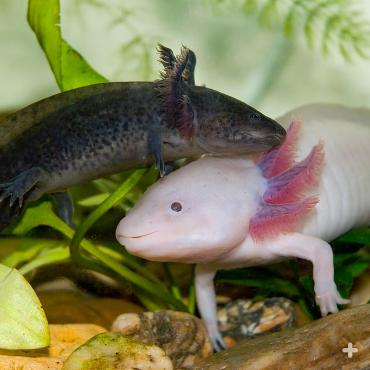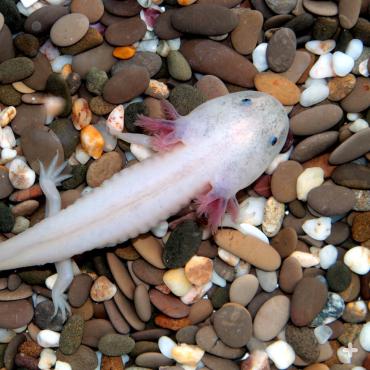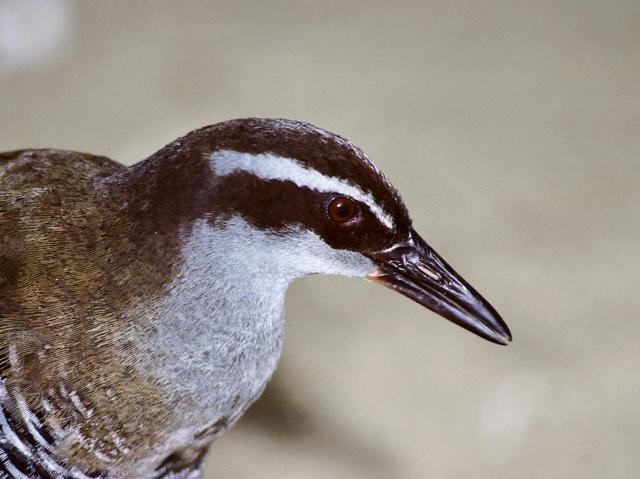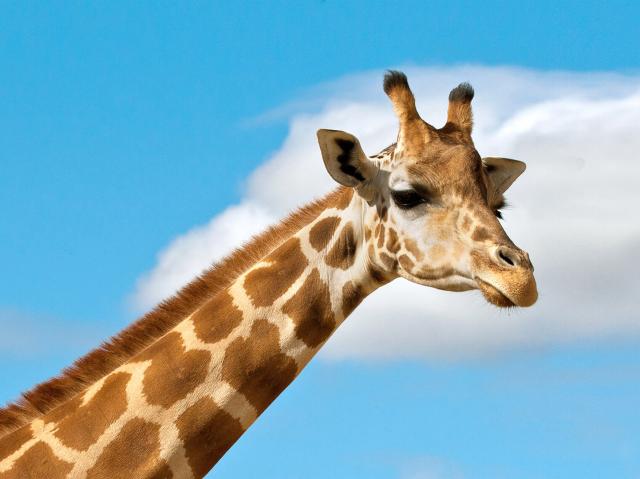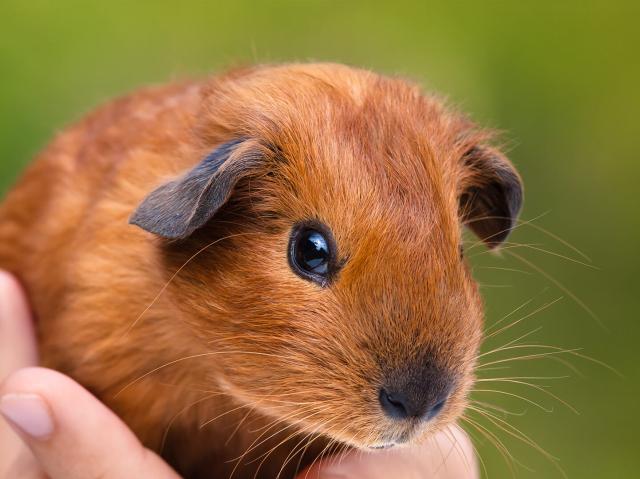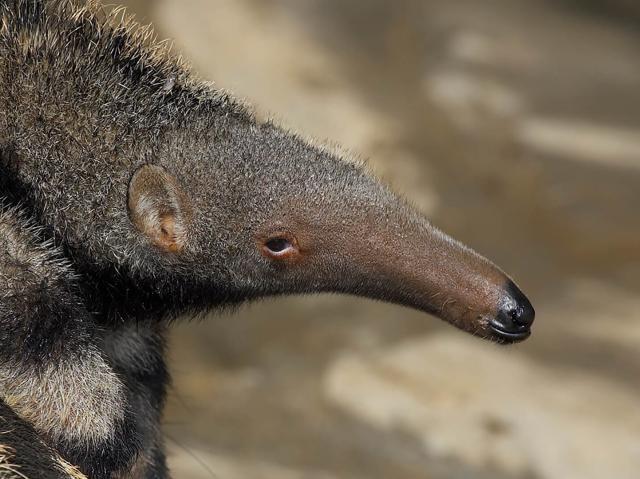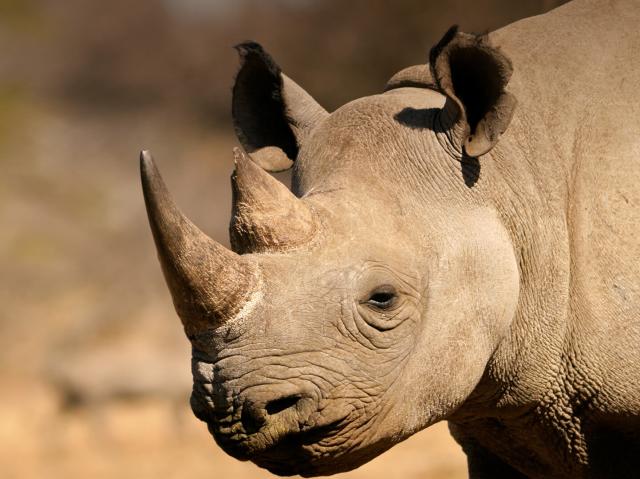
Axolotl

- Class: Amphibia
- Order: Caudata
- Family: Ambystomatidae
- Genus: Ambystoma
- Species: mexicanum

ABOUT
Shrouded in mystery, and defying typical biological laws like metamorphosis, the axolotl (pronounced AX-oh-lot-ul), a type of salamander, keeps its webbed feet firmly placed in infancy throughout its life.
Unlike other salamanders, axolotls are neotenic, meaning they keep juvenile characteristics into adulthood. Axolotls remain aquatic (like larvae) their entire life. Though they develop functional lungs, they use prominent, feathery gills to breathe underwater. Like youngsters, they retain external gills, a tail, and a body fin, and lack movable eyelids.
Once naturally occurring in a series of lakes and wetlands in the Mexican Central Valley, axolotl populations now live in just three isolated sites in the southern part of Mexico City, Mexico. Descended from tiger salamanders, axolotls are relatively “young," having inhabited central Mexico for only about the last 10,000 years, according to some experts. Indigenous to lakes Xochimilco and Chalco along the southern edge of the Basin of Mexico, much of their suitable habitat has been drained. The Xochimilco-Chalco basin, once about 77 square miles (200 square kilometers) of marshes, swamps, and lagoons, was significantly reduced 85 years ago when drainage projects were completed.
Many consider axolotls charismatic, and they're deeply connected to Mexican history, culture, and identity. That said, little information exists about the ecology of axolotl populations. This is surprising, given their popularity. However, their small and generally inaccessible populations make it difficult to learn about their behavior. What is known about axolotls has been primarily learned from populations cared for by people.
Axolotls have dark coloring to match their muddy lake habitats and can shift their hue a few shades lighter or darker as needed for camouflage. Although naturally dark, axolotls can be many colors: white (albino), pink, golden, or multicolored.
Axolotls have another icredible ability: they can regenerate their limbs, lungs, heart, jaws, spines, and even parts of their brain! Scientists have found that axolotls can regrow a new limb five times perfectly, in a few weeks—without even a scar. Every tissue is replaced: skin, bone, cartilage, muscle, and stem cells. Other organs can regenerate countless times and be completely functional. Naturally, scientists would like to understand this remarkable ability and explore how similar regenerative thereapies could help people. It is said that axolotls are over 1,000 times more resistant to cancer than mammals—another superpower worth investigating.

An axolotl can reach 12 inches in length, but on average grows to about 9 inches. They have broad, flat bodies with large heads donning signature feathery gills. Their mouths are often bent into a slight grin or are otherwise expressive. Round, dark eyes with yellow, iridescent irises take in the murky environment while lizard-like limbs carry it along the lake bottom. Axolotls weigh about as much as a deck of cards. In a pinch, they can move an astonishing 10 miles per hour (15 kilometers per hour).
HABITAT AND DIET
Axolotls are lentic, meaning they inhabit still-water lakes. They occur in only two: Mexico’s Lake Xochimilco and Lake Chalco, where they are Critically Endangered from the combined impacts of pollution, habitat degradation, and predation and competition from non-native species.
Despite their infantile appearance and undeveloped teeth, axolotls are effective predators, inhaling worms, mollusks, crustaceans, insect larvae, and even small fish! During the day, they burrow into aquatic vegetation and mud to avoid being eaten, and at night they become animated…and hungry. While they use their gills to breathe underwater, they may pop up to the surface for a quick gulp of air from time to time.
Using a suction technique, axolotls consume worms, tadpoles, insects, and small fish. Gravel may also get inhaled, which helps grind up food in their stomach (just as birds use grit to break down food for digestion).
Axolotls have few predators in the wild, though they may be taken by storks and herons, as well as large fish (carp and tilapia), on occasion. Their biggest threat is urbanization and pollution of the freshwater lakes and ponds they inhabit. Predation from introduced fish and large birds, as well as over-collecting them for food and medicine also contributes to their persistent decline.
Axolotls at the San Diego Zoo eat a variety of worms and insects. Visit the San Diego Zoo’s Denny Sanford Wildlife Explorers Basecamp today and discover more about axolotls inside Marsh Meadows.
FAMILY LIFE
Axolotls reach sexual maturity by about six months of age, followed by a breeding season between March and June, when water temperatures and levels are more temperate.
A waltz between a male and female initiates mating. They rub and slide against the other’s cloaca while twirling in a circular fashion. After about 30 seconds of vigorous tail waving, the male drops a “cone-shaped mass with a sperm cap.”
The female collects the cone with her cloaca after her own tail-shaking display, and the fertilization of her 300 to 1,000 eggs begins. She lays her eggs individually, placed on plants or rocks to avoid predators. Two weeks later, the eggs hatch and the youngsters are off and swimming. There is no parental care, so they figure it out as they go.
CONSERVATION
Axolotls live in two freshwater lakes in the middle of the largest city in the world: Mexico City. Growing populations of people compete for this freshwater resource, and pollution also contributes to this salamander’s decline.
To protect their future, habitat management and restoration are key. Conservationists have begun creating aquatic refuges for axolotls by installing water filters in Lake Xochimilco's canals and excluding non-native species like tilapia. Through conservation education, farmers are increasingly embracing traditional agricultural practices (free of pesticides and fertilizers) to help conserve axolotls.
You can help save endangered species like axolotls by supporting San Diego Zoo Wildlife Alliance as an ally for wildlife.
Life Span
10 to 15 years
Young
Gestation: 2 weeks
Number of young: 300 to 1,000 eggs
Age of maturity: 6-8 months
Size
Length: 8 to 12 inches (15 to 45 centimeters)
Weight: 2 to 8 ounces (56 to 226 grams)
Fun Facts
The word “axolotl” comes from the Nahuatl language of the Aztecs, and means “water dog.” Its mythological connection is to Xolotl, the god of fire, lightning, deformities, and death.
The Spanish word for axolotl is ajolote, but is used colloquially in Mexico to encompass all forms of salamander. It is also called the Mexican walking fish (though it is not a fish at all).
Nearly extinct in the wild, axolotls are one of Latin America’s most threatened amphibians.
Axolotls are part of the group of mole salamanders—which includes its closest relative, the tiger salamander Ambystoma tigrinum; and the more distant relative, the spotted salamander Ambystoma maculatum.



